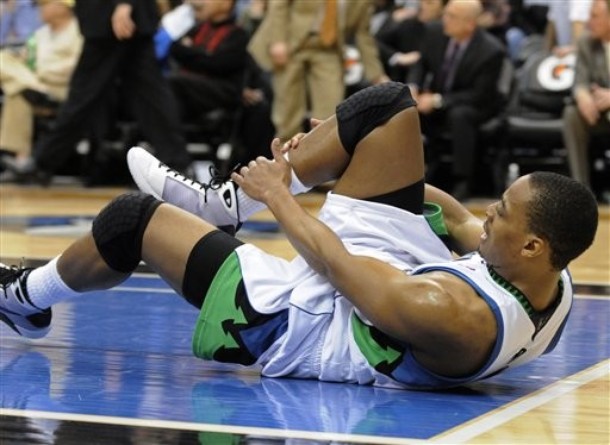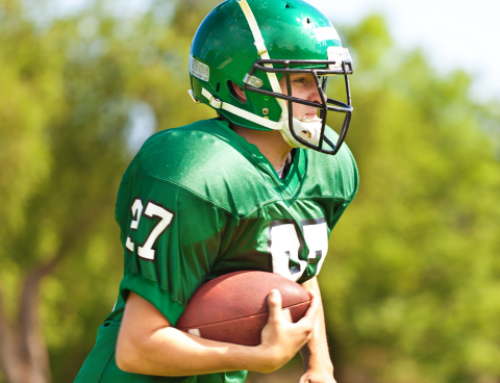Injury Prevention for the Ankles and Knees

Basketball is [or at least is supposed to be] played standing upright on two feet. Every movement a player makes on the court is initiated through the feet—every shot, every rebound, every pass. Everything starts with the feet.
With that said, one of most injury-prone spots for basketball players is connected to the feet—the ankles. Therefore, to keep your game at its best, it is important to protect your ankles [and by extension, your knees] from injury.
Every time you run or jump, you perform a triple extension. This means the ankles, knees and hips are all extended. If one of those joints is weak or tight or not working properly, it limits the function of the other two. Weak, tight ankles limit a player’s ability to run and jump to his or her potential. They also cause the body to compensate in a variety of ways during movement—which usually leads to knee issues. Remember, everything starts with the feet.
When you land from a jump or after each step while running, the impact is supposed to be diffused through your ankles, knees and hips. If your ankles are immobile and can’t move through a normal range of motion, the impact is directed to the next closest link in the chain—the knees.
Weak, immobile ankles cause additional stress on the knees when landing and running. They can also harm your performance on-court. On the other hand, strong and mobile ankles lessen the risk of injury, reduce time lost if an injury does occur, and improve performance on the court.
If you want to protect your ankles and knees, you need to do two things:
1. Strengthen the muscles of your feet, ankles and knees from a variety of angles.
Eliminating the stability of your shoes and ankle braces is an excellent way to strengthen your ankles and feet. To gain that strength, perform a variety of appropriate exercises without shoes.
Using a variety of safe movement drills is the most effective way to improve the mobility of your ankles and landing technique, and to protect your knees. You want to be comprehensive in your training, varying between jumping off of one foot and two feet.
As a veteran basketball-specific strength and conditioning coach, it is my job to keep players injury-free. If you follow those two steps, you will have stronger and more mobile ankles—which will also help your knees.
Photo: daylife.com
Alan Stein is the owner of Stronger Team and the head strength and conditioning coach for the nationally-renowned Nike Elite DeMatha Catholic High School boy’s basketball program. A performance consultant for Nike Basketball as well as the head conditioning coach for the annual McDonald’s All-American game, the Jordan Brand Classic and the Nike Summer Skills Academies, Stein is also a camp coach at the prestigious NBA Players Association’s Top 100 Camp and the Chris Paul CP3 Elite Backcourt Camp. You can follow Stein at twitter.com/AlanStein and Facebook.com/StrongerTeam.
RECOMMENDED FOR YOU
MOST POPULAR
Injury Prevention for the Ankles and Knees

Basketball is [or at least is supposed to be] played standing upright on two feet. Every movement a player makes on the court is initiated through the feet—every shot, every rebound, every pass. Everything starts with the feet.
With that said, one of most injury-prone spots for basketball players is connected to the feet—the ankles. Therefore, to keep your game at its best, it is important to protect your ankles [and by extension, your knees] from injury.
Every time you run or jump, you perform a triple extension. This means the ankles, knees and hips are all extended. If one of those joints is weak or tight or not working properly, it limits the function of the other two. Weak, tight ankles limit a player’s ability to run and jump to his or her potential. They also cause the body to compensate in a variety of ways during movement—which usually leads to knee issues. Remember, everything starts with the feet.
When you land from a jump or after each step while running, the impact is supposed to be diffused through your ankles, knees and hips. If your ankles are immobile and can’t move through a normal range of motion, the impact is directed to the next closest link in the chain—the knees.
Weak, immobile ankles cause additional stress on the knees when landing and running. They can also harm your performance on-court. On the other hand, strong and mobile ankles lessen the risk of injury, reduce time lost if an injury does occur, and improve performance on the court.
If you want to protect your ankles and knees, you need to do two things:
1. Strengthen the muscles of your feet, ankles and knees from a variety of angles.
Eliminating the stability of your shoes and ankle braces is an excellent way to strengthen your ankles and feet. To gain that strength, perform a variety of appropriate exercises without shoes.
Using a variety of safe movement drills is the most effective way to improve the mobility of your ankles and landing technique, and to protect your knees. You want to be comprehensive in your training, varying between jumping off of one foot and two feet.
As a veteran basketball-specific strength and conditioning coach, it is my job to keep players injury-free. If you follow those two steps, you will have stronger and more mobile ankles—which will also help your knees.
Photo: daylife.com
Alan Stein is the owner of Stronger Team and the head strength and conditioning coach for the nationally-renowned Nike Elite DeMatha Catholic High School boy’s basketball program. A performance consultant for Nike Basketball as well as the head conditioning coach for the annual McDonald’s All-American game, the Jordan Brand Classic and the Nike Summer Skills Academies, Stein is also a camp coach at the prestigious NBA Players Association’s Top 100 Camp and the Chris Paul CP3 Elite Backcourt Camp. You can follow Stein at twitter.com/AlanStein and Facebook.com/StrongerTeam.
















